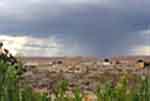Activity 3: Skills and Best Practices
Interpreting Climate Maps
- Latitude and its influence on solar radiation received.
- Air mass influences.
- Location of global high and low pressure zones.
- Heat exchange from ocean currents.
- Distribution of mountain barriers.
- Pattern of prevailing winds.
- Distribution of land and sea.
- Altitude.
The Koppen Climate Classification System A - Tropical Moist Climates: all months have average temperatures above 18° Celsius.
B - Dry Climates: with deficient precipitation during most of the year.
C - Moist Mid-latitude Climates: with Mild Winters.
D - Moist Mid-Latitude Climates: with Cold Winters.
E - Polar Climates: with extremely cold winters and summers.
Making Predictions
Teaching Writing in the Social Studies
Demonstrate How to Use Helpful Features of Expository Text
Many students fail to use expository text features that promote understanding and learning. Draw students' attention to helpful features, and model how to use them. For example, you might show a class how to use chapter titles, overviews, and headings to determine main ideas, make predictions about content, and set specific purposes for reading. If study questions are interpolated within the text, encourage students to use them to monitor their comprehension of a section of text. If questions are at the end of the entire text, discuss the questions in class before students read the text.
Social studies teachers have to be teachers of writing, speaking and listening. Just try to think how useful social studies information is to a person who lacks these skills.
This site, www.glencoe.com/sec/teachingtoday/subject/improving_reading.phtml, suggests some other easy strategies to help students become better readers and writers.
- Provide Advance Organizers
- Use Word Webs and Word Walls to Teach Vocabulary
- Use Role Plays and KWL Charts to Activate Prior Knowledge

 Module Menu
Module Menu Printable View
Printable View